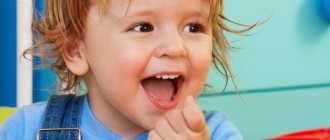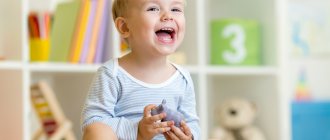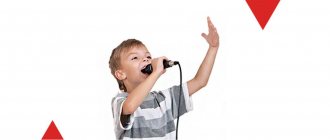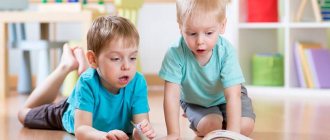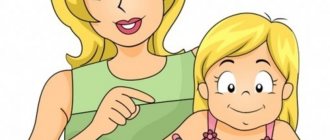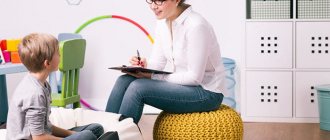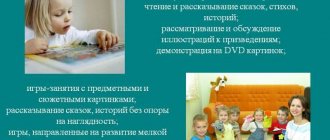Early childhood (2-3 years) is an important stage in the development of a child’s speech.
At this time, children are interested in everything that happens around them.
It is important for parents to support their child in every possible way in his endeavors, because the main guides to the world of new information are the adults in the immediate environment.
Where to begin?
You need to make sure that the child is developing normally physically and emotionally.
There are conventional norms for the development of children (height, weight, skills, abilities, vocabulary of the child).
They should be taken into account, but you shouldn’t get hung up on discrepancies.
It is better to contact a specialist who will compare all the factors influencing development and give a professional assessment of your child’s development.
What happens during the first lesson?
A full speech therapy examination and diagnosis often requires more than one session. Speech is a very complex process, so diagnostics are always carried out comprehensively.
- First, the speech therapist talks with the parents: it is necessary to find out how the child grew and developed, what illnesses and injuries he suffered, how the birth and pregnancy proceeded.
- Then the speech therapist examines the baby’s speech organs, assesses the condition of the teeth and the correctness of the bite.
- The next step is to assess gross motor skills. The speech therapist asks the child to walk, jump, and perform agility and balance tasks.
- Next, the speech therapist determines how many words are in the active and passive dictionary, whether the child can correctly use singular and plural forms, cases, and intonation. The teacher checks whether the pronunciation, tempo, expressiveness of speech, knowledge of the lexical and grammatical structure of the language corresponds to the age norm.
In conclusion, the speech therapist draws up an individual training program. The duration of correction depends on the complexity of the speech defect.
Features of speech therapy at 2-3 years
The main task of an adult when working with young children is to evoke onomatopoeia in any form.
Taking into account the psychology of children 2-3 years old, classes should be conducted in the form of outdoor games, varied and not long in time.
It is important to establish emotional contact with the child, interest him, gain trust, encourage activity, and praise.
This will help avoid many psychological problems associated with fear of speech.
From a small experience of speech therapy classes with children 3–4 years old
Victoria Lamm
From a small experience of speech therapy classes with children 3–4 years old
Speech therapy classes with children 3-4 years old will correct pronunciation and allow the child to learn to speak correctly faster.
Sometimes, for a number of reasons of a neurological, physical or mental nature, speech disorders result in a certain form.
This may be caused by poor vocabulary, incorrect pronunciation of words, confusion in endings or rearrangement of syllables of a word , and may also manifest itself in the pace of speech.
begin with children 3-4 years old , when a certain vocabulary is normally formed, and the child actively communicates or is forced to strive to explain his needs and desires verbally, and not through gestures.
Thanks to the fact that children themselves teach each other to explain themselves more clearly in a playful and natural way, the vocabulary and, accordingly, the speech of a child at 3-4 years old changes.
My speech therapy classes for children 3-4 years old include
• mandatory articulation exercises to relieve muscle tone and spasm,
• dynamic and static exercises for the tongue, corners of the lips, muscles of the lower jaw, cheeks,
• finger exercises and fine motor skills,
• sometimes reflexology massage.
During corrective classes , children learn spatial concepts, develop motor skills and memory, visual images, attention, thinking and observation.
Sensory functions develop, constructive thinking is practiced, and muscle tone is gradually normalized.
I conduct all classes They usually take the form of simple games and activities. Children most often do not understand that some kind of purposeful work is being done with them. They play with me, have fun and have fun.
One of the most common defects is the incorrect reproduction of hissing and whistling sounds. The following exercises can help correct the situation:
1. Dudochka. The child closes his teeth and stretches his lips with a pipe as far as possible. At the same time, you need to work with your tongue: up and down.
2. Cup. Ask your child to open his mouth wide, stick out his tongue and try to imitate a cup by bending the edges and tip.
3. Paint the sky ! The little one smiles, then opens her mouth. At the same time, he moves his tongue like a brush across the roof of the mouth.
4. The sound of a horse. A very popular pastime. The little one clicks the tip of his tongue like a horse.
5. We eat jam. Smile and open your mouth slightly. With the lower jaw motionless, lick the upper sponge.
6. Brush your teeth! Just do it not with a brush, but with a tongue.
I proceed from the principle: if you correct defects, then do it immediately and forever. classes at home with parents are also necessary . The family plays an important and decisive role in correctional work with . A lot of work is being done with parents, which is necessary to effectively solve the problems.
Only if the child is tired, you cannot insist! He should not feel pressure from an adult . It’s also good to draw along contours. They do this without much pleasure, but it is a useful thing.
At the same time, one should not be too zealous and fundamentally force the child to constantly use only correctly constructed words and phrases. This will lead to unnecessary stress and may discourage the child from studying.
With your baby, exercises should be performed unobtrusively, without focusing on existing problems. If the child is upset or depressed as a result, such training will not bring success. You will achieve nothing but isolation and an aggressive reaction.
In between classes , let him speak as before with errors, which may disappear spontaneously. At one point, parents are surprised and happy to see that the baby himself is trying to control the correctness of speech.
To develop fine motor skills, it is useful to massage each finger of the child, bend and straighten them, and play board games. Let your baby pick through cereal or play in the sand more often. At home, any bulk material is suitable instead.
Don't forget about articulation gymnastics. Pay as much attention as possible to reading, learn simple songs and rhymes with your baby.
I conduct speech therapy classes with children So you can use interesting pictures, according to which the child should compose a short story. Warming up the tongue greatly amuses them.
Some advice for parents of children with ODD.
1. Using the help of nature and the seasons. Decorate your apartment according to this time. It’s best in winter; all children love to decorate the Christmas tree. Pick up unbreakable toys, ask for help with tinsel, look at pictures, put together puzzles. Autumn is no less interesting! Collect leaves with your child, talk about trees, and decorate your home. You can make herbariums. It's exciting and will lift your spirits!
2. Put the picture together. It is not necessary to purchase puzzles; take any large picture and cut it. Let the child collect it. If he is familiar with numbers, number the parts, this will make it easier for the little one.
3. Joint creativity. Model from soft plasticine or salt dough. Ask your little one to make the little animal’s eyes and stick them on. Let him stretch his fingers. Kinetic sand is an excellent material for developing fine motor skills.
4. We provoke conversation! After reading an interesting fairy tale, discuss the plot together and ask more questions. If your child has a problem with a particular word, do not impose or forcefully correct it. Provoke the pronunciation of the problematic word. And speak more often, but correctly. The child will begin to repeat. In general, as far as pronunciation is concerned, what is said by loved ones must be correct. Don't distort it by lisp. The child reproduces the intonation!
5. Draw. Ask them to color, trace, and draw simple objects. It could be grass, sun, tree. By the age of 4, the child will cope with this.
Development of general imitation
General imitation is the copying of movements, actions, and facial expressions.
The child reproduces the movements he sees and successfully remembers them when repeated many times.
The mechanism of imitation works on a subconscious level in everyday life, and educators and speech therapists use it consciously when conducting classes with children.
It is important that the child is in the correct speech environment, i.e. it is better to limit communication with people who have speech defects. Watch your behavior - words should not contradict actions.
The development of general imitation begins with the repetition of elementary movements, then perform several actions simultaneously. The next stage is the implementation of a whole chain of actions that are logically connected and, as a rule, socially significant (for example, feeding a doll and putting it to bed).
When working with children, follow some rules: your sentences should be clear, simple and not too long; the speech of an adult is emotionally bright, calm, not loud.
General imitation games can be played with one child or with several (usually 3-5 children).
But! Keep in mind that when playing in a group, children imitate not only the adult, but also each other.
Games with general imitation
- Let's do exercises. The point of the game is to follow the adult’s commands (hands up, arms to the sides, jumping, clapping). To maintain interest and attention, invite the children to choose a leader from among themselves.
- Birds. Children play birds. An adult comments on every movement: “We fly like birds! Let's flap our wings up and down! Now the birds are pecking at the grains!” Gradually the pace of the game increases.
- Palms. A series of movements with the palms is performed:
“Palms up (put your palms on the table with the outer side down)!
Palms down (turn your palms over)!
And now put them on their sides (put our palms on their edges)!
And we clenched our fists (we clasp our palms into fists)!”
At first the movements are performed slowly, then faster and without the participation of an adult.
Tests to determine pathologies
To quickly respond to changes in the baby’s development, you can conduct simple tests.
- By the fourth year, children can already distinguish the simplest geometric shapes. You need to ask the child to draw a circle. Even the similarity of this figure is a good result. However, if the child does not understand what is wanted from him, or his drawing does not even remotely resemble what is required, the test has not been passed.
- If a child does not show interest in new games and does not assemble a small tower from cubes, development is slow.
- By the age of three, the toddler communicates in short phrases (those who at this age already speak in long sentences are not taken into account). The minimum milestone for speech development by 3-4 years is the simplest phrases. If the child does not pronounce them, you should go to a specialist.
Speech therapy rhymes and nursery rhymes during a lesson in the senior group
In what cases is it still necessary to contact a speech therapist:
- The baby does not respond to his name and does not understand simple requests.
- Shows no interest in new toys; all his game scenarios follow the pattern.
- He cannot assemble a simple turret or put a large bead on a rope.
- If by the age of three the child does not speak, there were injuries during pregnancy or early development, or there are hereditary diseases.
You should regularly conduct classes with children
Speech imitation
A child’s reproduction of sounds, words, and phrases is called speech imitation.
It is meaningful only when speech is closely related to the child’s actions.
An adult should stimulate the child's speech with questions.
Words to be repeated must be pronounced many times; do not repeat the child’s “substitute words.” The child’s answers are accepted in any form.
The most important thing is to do everything possible so that the child does not hesitate to speak.
Speech imitation goes through several stages:
- Copying sounds that have a certain meaning.
- Repetition of amorphous words (kup-kup - swim, am-am - eat, lalya - doll).
- Repetition of simple words (baba, grandfather, drink).
- Repeating short phrases: “Give me the juice!” Where's the spoon?
Pay great attention to the use of verbs. If a child’s speech contains many action words, his level of development is quite high.
Games with speech imitation
An effective way to induce speech imitation is the use of poetic texts - finishing words and phrases by creating pauses when reading poetry.
For example:
They love... (monkeys) very much
Eat sweets... (bananas).
We are like monkeys... (look like)
And we love bananas... (too).
Gradually, the number of pauses (words skipped by adults) can be increased, thereby increasing the child’s vocabulary.
Fun games in the form of a conversation: an adult repeats a word several times, then asks the child a question, the answer to which is the highlighted word. If the question is answered correctly, the adult praises the child; if the question is answered incorrectly, he answers the question himself or offers several answer options.
The role of the book
The book introduces the child to the world around him; develops logical and imaginative thinking, memory, imagination; expands vocabulary; teaches you how to write sentences correctly.
Through reading, a child learns to listen and concentrate.
Family reading is a way of communication between parents and children, a good method of education and a means of leisure.
Psychologists believe that children to whom their parents read books are more emotionally balanced and self-confident.
Book material for classes
The main features of a good book for a 2-3 year old child:
- High quality illustrations.
High-quality images attract the child and do not move his attention beyond the boundaries of the picture. In high-quality publications, the drawings are usually bright, clear, “spacious” (on a light background, for better visual perception of the child), realistic, and the images of the characters’ bodies are proportional. High-quality illustrations develop the baby’s aesthetic taste. Communication with a book for a child is the first acquaintance with the world of art.
- Conciseness of the text.
At 2-3 years old, children cannot yet listen to long fairy tales, so short rhythmic works (poems, songs, ditties, counting rhymes, riddles) and short stories and fairy tales are the best choice for children.
List of books for young children:
1. Russian folk tales (“Turnip”, “Teremok”, “Kolobok”, “Ryaba Hen”). Promotes the development of logical thinking. For example, in the fairy tale “Turnip”, the child remembers the characters in the order in which the heroes pulled the turnip - an excellent exercise for developing memory and logic.
2. Poems. Popular authors:
- A. Barto (collection “Toys”);
- K. Chukovsky (“Fairy Tales”);
- S. Marshak (“Poems and Fairy Tales”);
- lively, lively and humorous collections of poems by I. Tokmakova “Where the Fish Sleeps”, “The Sun Walks in a Circle”;
- unusual, with non-standard rhymes, poems by G. Sapgir “Wonder Forests”;
- S. Mikhalkov (“The Most Favorite Fairy Tales and Poems for Kids”) is known for his ability to tell children about their mischief and disobedience in a light, humorous manner.
3. Fairy tales of Russian authors - V. Suteev, “Fairy tales and pictures” (with the author’s own illustrations).
4. Fairy tales of foreign writers. A prominent representative is D. Donaldson. The most famous works are the fairy tale “The Gruffalo” (about a little mouse who was able to outwit the terrible monster Gruffalo), “The Gruffalo’s Little Daughter” (the book clearly traces a useful idea - you should not go far without asking your parents, it can be dangerous).
5. Educational books - help children learn to draw, glue, and sculpt.
How does a child's speech develop?
The norms for speech development are described by age, but all children develop differently. The permissible gap from peers is no more than six months. If the delay lasts longer, then you need to visit a speech therapist.
- During the first year of life, the child develops his first babble words. By 12 months, he should distinguish between gestures, simple words like “mom”, “give”, and pronounce 3-4 words.
- At 2 – 2.5 years old, the vocabulary vocabulary should be at least 50 words. The child speaks in phrases of 2-3 words. The sounds [b], [m], [f], [v], [t], [d], [n], [k], [g] appear.
- At the age of 3, children, as a rule, master the grammatical structure of their native language: they freely use case forms, singular and plural, and auxiliary parts of speech. The child speaks in sentences.
- At the age of 4, hissing and whistling sounds appear in speech, and sentences become more complex. The child actively communicates with peers and adults.
- In the speech of a five-year-old child, the most difficult sonorant sounds appear - [r] and [l]. Children pronounce other sounds well and speak familiar words clearly.
A child can learn a short poem or retell a story using pictures.
Contrary to popular belief that there is no point in going to a speech therapist before the age of 5, it is recommended that you show your child to a specialist at the age of three . This is especially important if
- you noticed that there is a lag in speech development, even if slight;
- the child does not attend kindergarten;
- you have already tried to practice on your own, but without visible results;
- the baby’s speech is difficult to understand, and only the mother can communicate with him;
- the child has suffered a head injury, severe stress, or severe infection in the past;
- the baby is being seen by a neurologist;
- The pregnancy was difficult, there was a difficult birth.
Serious deviations, as a rule, already manifest themselves by 3 years. It is extremely important not to waste time and begin correction. The sooner you start studying, the faster your child will be able to catch up with his peers. It’s not too early to start classes with a speech therapist at 3 years old. Three-year-olds are already good at completing tasks, repeating after an adult, and are willing to make contact.
Influence of motor skills
The development of speech directly depends on the development of fine motor skills, since the areas of the brain responsible for speech and movement are interdependent and located nearby.
There are many different aids and toys on the market for developing fine motor skills, but you don’t need special expensive toys to play with your child.
In fact, every home has everything you need - beans, pasta, buttons, lids, jars, etc.
The sooner work on developing fine motor skills begins, the sooner it will begin to bear fruit.
What activities can be done with your child at home for speech development?
It's no secret that children spend most of their time at home.
Note! Therefore, it is so important to properly organize the baby’s activities aimed at developing children’s speech.
Articulation gymnastics and pronunciation training
Basically, all speech therapy classes for children 3-4 years old begin with small gymnastics for the organs of articulation. Most popular:
- Smile - stretch your lips in a smile, showing your teeth (the same without teeth).
- Dudochka - fold your lips into a tube and stretch them forward.
- Balloon - inflate your cheeks and hold the air for 3-5 seconds.
- Shoulder blade - place your tongue outstretched on the lower lip and fix it.
- Needle - tighten the tongue very much, make it as thin as possible and pull it forward, fix it.
- Jam - lick your upper and lower lips with your tongue.
- Let's brush our teeth - run your tongue over the upper teeth, then over the lower ones.
- Hill - the tongue rests on the lower teeth, while the middle of it tends to the palate, forming a hill. With this training, the child remembers the position of the tongue used to pronounce many sounds.
Games for hearing development
Children of primary preschool age are offered games to distinguish the volume of a sound or recognize an object that makes a sound. For many speech therapy tasks offered to children 3-4 years old, musical instruments such as pipes, drums, and piano are used.
Also at this age it is already possible to teach a child to distinguish sounds by ear. This can be done by offering a game: “Clap your hands when you hear the song of the water (sound “S”): sleep, frame, braid, mom, Sasha, etc.”
Important! It is best to call sounds by special “names”: the sound “S” is the song of the water, the sound “Sh” is the hiss of a snake, etc. It will be easier for the child to remember and orientate himself. When pronouncing a word in which the baby must highlight the sound, it should be exaggerated.
Finger gymnastics
This gymnastics is used as an activity for the development of speech for 4 years at home and in preschool educational institutions. By this age, the baby understands simple instructions and is able to follow them, and children's fine motor skills are already sufficiently developed to make small “compositions” from their fingers. Here are some of them:
- Lock - hands are tightly clasped in a lock, with the fingers of both hands intertwined with each other.
- Scratching - alternately depict “paws” with your right and left hands.
- Let's warm up our hands by rubbing our left palm vigorously with our right palm.
- Glasses - make a circle with the thumb and index finger of each hand and bring it to your eyes - put on glasses.
Poetry learning, reading and storytelling
Children 3-4 years old often learn poetry, retell fairy tales, and learn to read during speech therapy sessions at home. This is facilitated by numerous manuals and workbooks for younger preschoolers, which can be purchased at any children's store or printed from the Internet.
The best authors of children's fiction: Korney Chukovsky, Alexander Pushkin, Agnia Barto, Samuil Marshak. The main task of memorizing short poems and retellings of works is to enrich the child’s vocabulary, expand his fantasy and imagination.
Note! In 2022, Bardysheva T.Yu. and Monosova E.N. published a special manual aimed at the comprehensive speech development of children of primary preschool age. The notebook by Monosova and Bardysheva consists of 120 pages of high-quality exercises and games that help increase the child’s active and passive vocabulary, develop phonemic awareness and coherent speech, and improve the processes of thinking, attention and memory. This manual was created both for professional speech therapists and defectologists, and for parents - it is written in simple and understandable language.
Fun workout
Outdoor games strengthen the muscles of the child’s body, prevent flat feet, develop coordination of movement, and contribute to the development of motor skills and speech.
Types of outdoor games:
- different types of walking (side step, walking on heels, toes);
- climbing, overcoming obstacles;
- ball games;
- balance exercises (sliding down a hill, walking on an inclined bench).
Articulation gymnastics for stuttering
Stuttering is a speech problem that is sometimes difficult to treat. Success can only be achieved through daily training.
Articulatory gymnastics for stuttering is one of the best, because it is aimed at strengthening the muscles of the articulatory apparatus.
Examples of exercises:
- inflate your cheeks, release air, inflate each cheek in turn;
- clap your lips together (like a fish);
- press your tongue on one or the other cheek in turn;
- puff out your cheeks while closing your mouth, then hit your cheeks with your fists to release the air noisily;
- bite the upper and then the lower lip.
The age of early development (2-3 years) is a short, but truly unique period of life, when the child’s brain is programmed for intensive formation and learning. Parents should pay special attention to the child, because it is at this time that the foundation is laid for the development of the baby’s speech and thinking.
Types and features of speech therapy classes
Speech therapy sessions can be either individual or group. On the one hand, one-on-one sessions have proven to be more effective, when all the specialist’s attention is directed to a specific child. On the other hand, children feel more comfortable in a group. Most often, a positive result is achieved by alternating these two types of activities: in group, or frontal, classes, children consolidate the skills acquired in individual ones.
Individual sessions
The most important thing for a speech therapist here is to find an approach to the child, to be able to captivate him, to “stir up” him. The baby should feel at ease, play, stick out his tongue in front of the mirror, and repeat after the specialist everything he asks. Therefore, the mood for the lesson is appropriate: it’s all just a game. To learn to pronounce difficult sounds, a child does not even need to know why he came here. For each such sound, the speech therapist has a selection of special game exercises, by performing which the little student imperceptibly improves his speech skills. Breathing exercises, songs, tongue twisters, tongue exercises - all these are effective tools in a specialist’s arsenal.
Group (frontal) classes
If individual speech therapist sessions with children are most often aimed at correcting individual sounds, then frontal sessions involve working with a wider range of deviations in speech development. These can be defects in sound pronunciation, hearing impairment, grammatical problems, and stuttering. Groups are selected small, ideally 7 people; children should be approximately the same age and have similar speech impairments. The lesson is always given some interesting topic, which provides many opportunities to expand children's vocabulary and practice oral speech. For example, in winter, the “New Year” theme is relevant: the room is decorated accordingly, creating a festive, upbeat mood in children, which contributes to the effectiveness of exercises.
As in individual lessons, here a lot depends on the personality of the specialist, on his ability to create the right environment and make children want to express themselves. For children 3-4 years old, for whom the process of socialization is just beginning, it is not easy to create such conditions. Many of them are shy and withdrawn precisely because of their speech impairments. For group speech therapy classes to bear fruit, children must feel confident and free during them.

